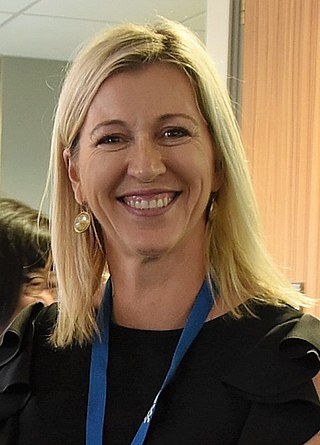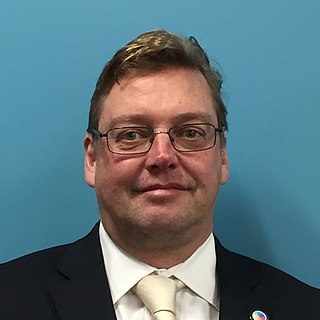
Richard John Blaikie (born 25 August 1965) is a physicist who works in the field of nano-scale optics. He is currently Deputy Vice-Chancellor (Research and Enterprise) at the University of Otago.

Richard John Blaikie (born 25 August 1965) is a physicist who works in the field of nano-scale optics. He is currently Deputy Vice-Chancellor (Research and Enterprise) at the University of Otago.
Blaikie was born in 1965 and attended Kaikorai Valley College in Dunedin. [1] He studied at the University of Otago (1984–1987) and graduated with a BSc (Hons) in physics. He won a Rutherford Memorial Scholarship to attend the University of Cambridge (1988–1992), where he received a PhD in physics in 1992.
After a year at the Hitachi Cambridge Laboratory, he took a position as a lecturer at the University of Canterbury. [2] He was at Canterbury from February 1994 to November 2011, and he was made a professor during that time. In 2001, he was a Fulbright Fellow at the Massachusetts Institute of Technology. [3]
When the MacDiarmid Institute for Advanced Materials and Nanotechnology was formed in 2002, he was appointed Deputy Director under Professor Paul Callaghan. When Callaghan retired in 2008, Blaikie was appointed Director. [3] During his tenure, the institute received a bequest of NZ$1 million. [4] Blaikie stepped down from the MacDiarmid Institute half way through 2011 when he received his appointment as Deputy Vice-Chancellor (Research and Enterprise) at the University of Otago. He took up the role in December 2011, succeeding Harlene Hayne. [3] [5] He also holds a chair in physics. [5]
Blaikie received the T. K. Sidey Medal in 2001, set up by the Royal Society of New Zealand as an award for outstanding scientific research. [6] [7] In 2011, Blaikie was elected fellow of the Royal Society of New Zealand. [8] In 2013, Blaikie received the Hector Memorial Medal from the Royal Society "for his fundamental and wide-ranging contributions to the field of nano-optics, showing that light can be manipulated at scales much smaller than its wavelength and providing a world-first demonstration of a controversial superlens system using subwavelength techniques." [9] [10] [11] The national ceremony for a range of Royal Society awards were held in the Dunedin Town Hall on 27 November 2013. [12] In 2015, Blaikie was awarded the Thomson Medal for science leadership. [13]
The MacDiarmid Institute for Advanced Materials and Nanotechnology is a New Zealand Centre of Research Excellence (CoRE) specialising in materials science and nanotechnology. It is hosted by Victoria University of Wellington, and is a collaboration between five universities and two Crown Research Institutes.

Alan Graham MacDiarmid, ONZ FRS was a New Zealand-born American chemist, and one of three recipients of the Nobel Prize for Chemistry in 2000.

The Rutherford Medal is the most prestigious award offered by the Royal Society of New Zealand, consisting of a medal and prize of $100,000. It is awarded at the request of the New Zealand Government to recognize exceptional contributions to the advancement and promotion of public awareness, knowledge and understanding in addition to eminent research or technological practice by a person or group in any field of science, mathematics, social science, or technology. It is funded by the New Zealand government and awarded annually.
Sir Michael Pepper is a British physicist notable for his work in semiconductor nanostructures.

Daniel Frank Walls FRS was a New Zealand theoretical physicist specialising in quantum optics.

Sir Paul Terence Callaghan was a New Zealand physicist who, as the founding director of the MacDiarmid Institute for Advanced Materials and Nanotechnology at Victoria University of Wellington, held the position of Alan MacDiarmid Professor of Physical Sciences and was President of the International Society of Magnetic Resonance.

Kaikorai Valley College is a large co-educational secondary school in Dunedin, New Zealand. Initially starting as Kaikorai Valley High School in 1958, the school combined with Kenmure Intermediate School in 1996 to become Kaikorai Valley College,. It celebrated its 50th jubilee in 2008.
James A. (Jim) Piper was a New Zealand/Australian physicist, Deputy Vice-Chancellor (Research) and Professor of Physics at Macquarie University.
Pablo Gabriel Etchegoin was an Argentine-New Zealand physicist.
Jeffery Lewis Tallon is a New Zealand physicist specialising in high-temperature superconductors.
Keith Andrew Hunter was a New Zealand ocean chemist who was a professor of chemistry and pro-vice-chancellor of sciences, at the University of Otago.

Michelle Emma Dickinson, also known as Nanogirl, is a nanotechnologist and science educator based in New Zealand.
Chennupati Jagadish, an Indian-Australian physicist and academic, is the President of the Australian Academy of Science, and a Distinguished Professor of Physics at the Australian National University Research School of Physics. He is head of the Semiconductor Optoelectronics and Nanotechnology Group which he established in 1990. He is also the Convener of the Australian Nanotechnology Network and Director of Australian National Fabrication Facility ACT Node.

Miriam Cather Simpson is a New Zealand-American physics/chemistry academic and entrepreneur. She is currently a professor at the University of Auckland, a joint appointment between the physics and chemistry departments. She is the founder of the Photon Factory laser lab at the University of Auckland and the chief science officer for two spin-off companies, Engender Technologies and Orbis Diagnostics. She is an Associate Investigator for the Dodd-Walls Centre for Photonic and Quantum Technologies and an Emeritus Investigator for the MacDiarmid Institute for Advanced Materials and Nanotechnology. She was awarded the Royal Society Te Apārangi Pickering Medal in 2019. She has a strong focus on teaching, mentoring and public outreach and is an outspoken advocate for issues of gender equality and ethics in science.

Merryn Tawhai is a New Zealand engineering scientist. She is a professor at the University of Auckland, director of the Auckland Bioengineering Institute, where she was a fellow from 2002, and a former director of MedTech CoRE. She is known for the development of mathematical models of the lungs that will help scientists understand differences between physiologically normal lungs and the pathological changes that might occur in a disease. She was inducted into the International Academy of Medical and Biological Engineering in June 2018. In November 2018, Tawhai was elected a Fellow of the Royal Society of New Zealand.

David A. W. Hutchinson is a quantum physicist and professor at the University of Otago, Dunedin, New Zealand. He is the inaugural and current Director of the Dodd-Walls Centre for Photonic and Quantum Technologies, a New Zealand government-funded national Centre of Research Excellence. Hutchinson's research interests are in the areas of quantum biology, Bose-Einstein condensates, and the underlying mathematics of quantum physics.

Richie Graham Poulton is a New Zealand psychologist and the director of the University of Otago's Dunedin Multidisciplinary Health & Development Research Unit, which runs the Dunedin Multidisciplinary Health and Development Study. He is also a professor of psychology at the University of Otago, the 2007 founder and co-director of the National Centre for Lifecourse Research, the founder in 2011 of the Graduate Longitudinal Study, New Zealand, and the chief science adviser of the Ministry of Social Development in the New Zealand government.

Shaun Cameron Hendy is a New Zealand physicist. He is the chief scientist at climate innovation company Toha. He was previously a professor at the University of Auckland and was the first director of Te Pūnaha Matatini, a centre of research excellence in complex systems and data analytics. During the COVID-19 pandemic in New Zealand, he led a team of scientists developing mathematical models of the spread of the virus across the country that influenced the government's response to the outbreak.

The Dodd-Walls Centre for Photonic and Quantum Technologies is a New Zealand Centre of Research Excellence, established in 2015, hosted by the University of Otago, and composed of researchers in six New Zealand universities as well as partner institutions in the US, United Kingdom, and Singapore. It does fundamental research on the quantum nature of matter, the physics and optics of light, and the manipulation of individual photons. New knowledge and applications are commercialised for industries including agritech, medicine, and civil engineering.
Kathryn McGrath is a New Zealand chemical scientist. She is deputy vice-chancellor (research) at the University of Technology Sydney, Australia.